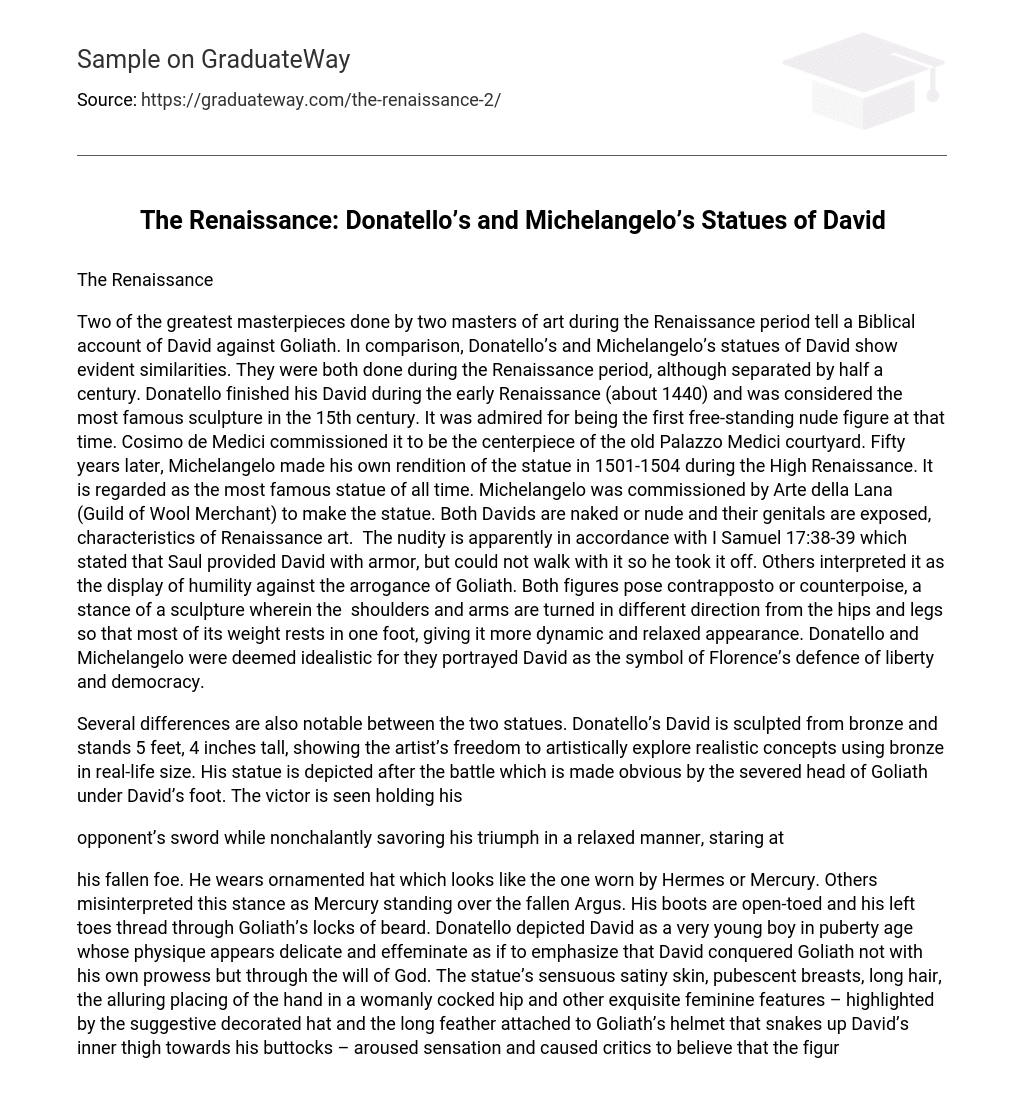Two of the greatest masterpieces done by two masters of art during the Renaissance period tell a Biblical account of David against Goliath. In comparison, Donatello’s and Michelangelo’s statues of David show evident similarities. They were both done during the Renaissance period, although separated by half a century. Donatello finished his David during the early Renaissance (about 1440) and was considered the most famous sculpture in the 15th century. It was admired for being the first free-standing nude figure at that time. Cosimo de Medici commissioned it to be the centerpiece of the old Palazzo Medici courtyard. Fifty years later, Michelangelo made his own rendition of the statue in 1501-1504 during the High Renaissance.
It is regarded as the most famous statue of all time. Michelangelo was commissioned by Arte della Lana (Guild of Wool Merchant) to make the statue. Both Davids are naked or nude and their genitals are exposed, characteristics of Renaissance art. The nudity is apparently in accordance with I Samuel 17:38-39 which stated that Saul provided David with armor, but could not walk with it so he took it off. Others interpreted it as the display of humility against the arrogance of Goliath. Both figures pose contrapposto or counterpoise, a stance of a sculpture wherein the shoulders and arms are turned in different direction from the hips and legs so that most of its weight rests in one foot, giving it more dynamic and relaxed appearance. Donatello and Michelangelo were deemed idealistic for they portrayed David as the symbol of Florence’s defence of liberty and democracy.
Several differences are also notable between the two statues. Donatello’s David is sculpted from bronze and stands 5 feet, 4 inches tall, showing the artist’s freedom to artistically explore realistic concepts using bronze in real-life size. His statue is depicted after the battle which is made obvious by the severed head of Goliath under David’s foot. The victor is seen holding his opponent’s sword while nonchalantly savoring his triumph in a relaxed manner, staring at
his fallen foe. He wears ornamented hat which looks like the one worn by Hermes or Mercury. Others misinterpreted this stance as Mercury standing over the fallen Argus. His boots are open-toed and his left toes thread through Goliath’s locks of beard. Donatello depicted David as a very young boy in puberty age whose physique appears delicate and effeminate as if to emphasize that David conquered Goliath not with his own prowess but through the will of God. The statue’s sensuous satiny skin, pubescent breasts, long hair, the alluring placing of the hand in a womanly cocked hip and other exquisite feminine features – highlighted by the suggestive decorated hat and the long feather attached to Goliath’s helmet that snakes up David’s inner thigh towards his buttocks – aroused sensation and caused critics to believe that the figure was originally conceptualized as a female.
The statue’s frailty is deviation from the traditional powerfully-built male figure. It is hard to imagine that a moment ago, this beautiful youth defeated a fierce giant in a combat. On the other hand, Michelangelo’s David stands a towering height of almost eighteen feet and was referred to as “Il Gigante.” He created the statue out of a huge marble block which was already been worked on earlier and abandoned by another artist. He used the style of disegno, an artistic discipline built on knowledge of the male human form which is considered the highest form of art. David is depicted as an athletic youth with manly character, heroic strength, focused gaze and ready to confront the enemy.
The artist chooses not to cover or adorn his creation with any garments to emphasize his well-built physique. Unlike Donatello, Michelangelo portrayed his David before the fight as the figure appears to pull to the left, away from the enemy, the sling flings over his shoulder and gazes in the distance. His anticipation of the inevitable battle is noticeable in his tensed muscle, swelling veins and the scowl in his face. In totality, the David of Michelangelo is a display of youthful arrogance, power and confidence –like a god who descends from the skies to purge the earth.
References:
- Donway, Roger.Michelangelo’s David. The Atlas Society. Retrieved April 12, 2009 from http://www.objectivistcenter.org/cth–838-Michelangelos_David.aspx
- Shaked, Guy. Donato de’ Bardi ditto Donatello: The Bronze David. Retrieved April 12, 2009 from http://www.geocities.com/Vienna/Choir/4792/donatello.html





